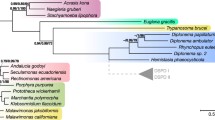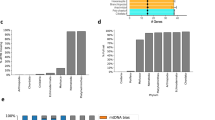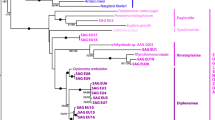Abstract
Phylum Euglenozoa comprises three groups of eukaryotic microbes (kinetoplastids, diplonemids, and euglenids), the mitochondrial (mt) genomes of which exhibit radically different modes of organization and expression. Gene fragmentation is a striking feature of both euglenid and diplonemid mtDNAs. To rationalize the emergence of these highly divergent mtDNA types and the existence of insertion/deletion RNA editing (in kinetoplastids) and trans-splicing (in diplonemids), we propose that in the mitochondrion of the common evolutionary ancestor of Euglenozoa, small expressed gene fragments promoted a rampant neutral evolutionary pathway. Interactions between small antisense transcripts of these gene fragments and full-length transcripts, assisted by RNA-processing enzymes, permitted the emergence of RNA editing and/or trans-splicing activities, allowing the system to tolerate indel mutations and further gene fragmentation, respectively, and leading to accumulation of additional mutations. In this way, dramatically different mitochondrial genome structures and RNA-processing machineries were able to evolve. The paradigm of constructive neutral evolution acting on the widely different mitochondrial genetic systems in Euglenozoa posits the accretion of initially neutral molecular interactions by genetic drift, leading inevitably to the observed ‘irremediable complexity’.

Similar content being viewed by others
References
Adl S, Simpson AGB, Farmer MA, Andersen RA et al (2005) The new higher level classification of eukaryotes with emphasis on the taxonomy of protists. J Euk Microbiol 52:399–451
Benne R (1990) RNA editing in trypanosomes—is there a message? Trends Genet 6:177–181
Blom D, de Haan A, van den Berg M, Sloof P, Jirků M, Lukeš J, Benne R (1998) RNA editing in the free-living bodonid Bodo saltans. Nucl Acids Res 26:1205–1213
Cavalier-Smith T (1997) Cell and genome coevolution: facultative anaerobiosis, glycosomes and kinetoplastan RNA editing. TIG 13:6–9
Covello PS, Gray MW (1993) On the evolution of RNA editing. Trends Genet 9:265–268
Deschamps P, Lara E, Marande W, López-García P, Ekelund F, Moreira D (2011) Phylogenomic analysis of kinetoplastids supports that trypanosomatids arose from within bodonids. Mol Biol Evol 28:53–58
Flegontov P, Lai DH, Jirků M, Janouškovec J, Oborník M, Keeling PJ, Lukeš J (submitted) The mitochondrial genome of Chromera velia encodes a single conserved gene
Gao G, Kapushoc ST, Simpson AM, Thiemann OH, Simpson L (2001) Guide RNAs of the recently isolated LEM125 strain of Leishmania tarentolae: an unexpected complexity. RNA 7:1335–1347
Golden DE, Hajduk SL (2005) The 3′-untranslated region of cytochrome oxidase II mRNA functions in RNA editing of African trypanosomes exclusively as a cis guide RNA. RNA 11:29–37
Gray MW (2003) Diversity and evolution of mitochondrial RNA editing systems. IUBMB Life 55:227–233
Gray MW, Lang BF, Burger G (2004) Mitochondria of protists. Annu Rev Genet 38:477–524
Gray MW, Lukeš J, Archibald JM, Keeling PJ, Doolittle WF (2010) Irremediable complexity? Science 330:920–921
Hampl V, Hug L, Leigh JW, Dacks JB, Lang BF, Simpson AG, Roger AJ (2009) Phylogenetic analyses support the monophyly of Excavata and resolve relationships among eukaryotic “supergroups”. Proc Natl Acad Sci USA 106:3859–3864
Horton TL, Landweber LF (2002) Rewriting the information in DNA: RNA editing in kinetoplastids and myxomycetes. Curr Opin Microbiol 5:620–626
Keeling PJ, Leander BS, Lukes J (2010) Reply to Speijer et al.: Does complexity necessarily arise from selective advantage? Proc Natl Acad Sci USA 107:E26
Kiethega GN, Turcotte M, Burger G (2011) Evolutionary conserved cox1 trans-splicing without cis-motifs. Mol Biol Evol. doi:10.1093/molbev/msr075
Kolesnikov AA, Merzliak EM, Bessolitsyna EA, Fediakov AV, Schonian G (2003) Reduction of the edited domain of the mitochondrial A6 gene for ATPase subunit 6 in Trypanosomatidae. Mol Biol (Mosk) 37:637–642
Koonin EV (2009) Darwinian evolution in the light of genomics. Nucl Acids Res 37:1011–1034
Lai DH, Hashimi H, Lun ZR, Ayala FJ, Lukeš J (2008) Adaptations of Trypanosoma brucei to gradual loss of kinetoplast DNA: Trypanosoma equiperdum and Trypanosoma evansi are petite mutants of T. brucei. Proc Natl Acad Sci USA 105:1999–2004
Landweber LF, Gilbert W (1993) RNA editing as a source of genetic variation. Nature 363:179–182
Lin S, Zhang H, Spencer DF, Norman JE, Gray MW (2002) Widespread and extensive editing of mitochondrial mRNAs in dinoflagellates. J Mol Biol 320:727–739
Liu B, Liu Y, Motyka SA, Agbo EE, Englund PT (2005) Fellowship of the rings: the replication of kinetoplast DNA. Trends Parasitol 21:363–369
Lukeš J, Arts GJ, van den Burg J, de Haan A, Opperdoes F, Sloof P, Benne R (1994) Novel pattern of editing regions in mitochondrial transcripts of the cryptobiid Trypanoplasma borreli. EMBO J 13:5086–5098
Lukeš J, Jirků M, Avliyakulov N, Benada O (1998) Pankinetoplast DNA structure in a primitive bodonid flagellate, Cryptobia helicis. EMBO J 17:838–846
Lukeš J, Guilbride DL, Votýpka J, Zíková A, Benne R, Englund PT (2002) Kinetoplast DNA network: evolution of an improbable structure. Eukaryot Cell 1:495–502
Lukeš J, Hashimi H, Zíková A (2005) Unexplained complexity of the mitochondrial genome and transcriptome in kinetoplastid flagellates. Curr Genet 48:277–299
Lukeš J, Leander BS, Keeling PJ (2009) Cascades of convergent evolution: the corresponding evolutionary histories of euglenozoans and dinoflagellates. Proc Natl Acad Sci USA 106:9963–9970
Lukeš J, Archibald JM, Keeling PJ, Doolittle WF, Gray MW (2011) How a neutral evolutionary ratchet can build cellular complexity. IUBMB Life, accepted
Lun ZR, Lai DH, Li FJ, Lukeš J, Ayala FJ (2010) Trypanosoma brucei: two steps to spread out from Africa. Trends Parasitol 26:424–427
Lynch M (2007) The frailty of adaptive hypotheses for the origins of organismal complexity. Proc Natl Acad Sci USA 104:8597–8604
Lynch M, Conery JS (2003) The origins of genome complexity. Science 302:1401–1404
Marande W, Burger G (2007) Mitochondrial DNA as a genomic jigsaw puzzle. Science 318:415
Marande W, Lukeš J, Burger G (2005) Unique mitochondrial genome structure in diplonemids, the sister group of kinetoplastids. Eukaryot Cell 4:1137–1146
Maslov DA, Avila HA, Lake JA, Simpson L (1994) Evolution of RNA editing in kinetoplastid protozoa. Nature 368:345–348
Moreira D, López-García P, Vickerman K (2004) An updated view of kinetoplastid phylogeny using environmental sequences and a closer outgroup: proposal for a new classification of the class Kinetoplastea. Int J Syst Evol Microbiol 54:1861–1875
Nash EA, Barbrook AC, Edwards-Stuart RK, Bernhardt K, Howe CJ, Nisbet RE (2007) Organization of the mitochondrial genome in the dinoflagellate Amphidinium carterae. Mol Biol Evol 24:1528–1536
Nash EA, Nisbet RER, Barbrook AC, Howe CJ (2008) Dinoflagellates: a mitochondrial genome all at sea. Trends Genet 24:328–335
Nawathean P, Maslov DA (2000) The absence of genes for cytochrome c oxidase and reductase subunits in maxicircle kinetoplast DNA of the respiration-deficient plant trypanosomatid Phytomonas serpens. Curr Genet 38:95–103
Ochsenreiter T, Hajduk SL (2006) Alternative editing of cytochrome c oxidase III mRNA in trypanosome mitochondria generates protein diversity. EMBO Rep 7:1128–1133
Ochsenreiter T, Hajduk SL (2007) The function of RNA editing in trypanosomes. In: Goringer HU (ed) RNA editing. Springer-Verlag, Berlin-Heidelberg, pp 181–197
Ochsenreiter T, Cipriano M, Hajduk SL (2008) Alternative mRNA editing in trypanosomes is extensive and may contribute to mitochondrial protein diversity. PLoS One 3:e1566
Roy J, Faktorová D, Lukeš J, Burger G (2007) Unusual mitochondrial genome structures throughout the Euglenozoa. Protist 158:385–396
Savill NJ, Higgs PG (1999) A theoretical study of random segregation of minicircles in trypanosomatids. Proc Biol Sci 266:611–620
Schnaufer A (2010) Evolution of dyskinetoplastic trypanosomes: how, and how often? Trends Parasitol 26:557–558
Schnaufer A, Domingo GJ, Stuart K (2002) Natural and induced dyskinetoplastic trypanosomatids: how to live without mitochondrial DNA. Int J Parasitol 32:1071–1084
Schnaufer A, Clark-Walker GD, Steinberg AG, Stuart K (2005) The F1–ATP synthase complex in bloodstream stage trypanosomes has an unusual and essential function. EMBO J 24:4029–4040
Simpson L, Maslov DA (1999) Evolution of the U-insertion/deletion RNA editing in mitochondria of kinetoplastid protozoa. Ann NY Acad Sci 870:190–205
Simpson AG, Roger AJ (2004) Protein phylogenies robustly resolve the deep-level relationships within Euglenozoa. Mol Phylogenet Evol 30:201–212
Simpson L, Thiemann OH, Savill NJ, Alfonzo JD, Maslov DA (2000) Evolution of RNA editing in trypanosome mitochondria. Proc Natl Acad Sci USA 97:6986–6993
Speijer D (2006) Is kinetoplastid pan-editing the result of an evolutionary balancing act? IUBMB Life 58:91–96
Speijer D (2007) Evolutionary aspects of RNA editing. In: Goringer HU (ed) RNA editing. Springer-Verlag, Berlin-Heidelberg, pp 199–227
Speijer D (2010) Constructive neutral evolution cannot explain current kinetoplastid panediting patterns. Proc Natl Acad Sci USA 107:E25
Speijer D (2011) Does constructive neutral evolution play an important role in the origin of cellular complexity? Making sense of the origins and uses of biological complexity. BioEssays. doi:10.1002/bies.201100010
Spencer DF, Gray MW (2011) Ribosomal RNA genes in Euglena gracilis mitochondrial DNA: fragmented genes in a seemingly fragmented genome. Mol Genet Genomics 285:19–31
Stoltzfus A (1999) On the possibility of constructive neutral evolution. J Mol Evol 49:169–181
Stuart K, Allen TE, Heidmann S, Seiwert SD (1997) RNA editing in kinetoplastid protozoa. Microbiol Mol Biol Rev 61:105–120
Tessier LH, van der Speck H, Gualberto JM, Grienenberger JM (1997) The cox1 gene from Euglena gracilis: a protist mitochondrial gene without introns and genetic code modifications. Curr Genet 31:208–213
Thiemann OH, Maslov DA, Simpson L (1994) Disruption of RNA editing in Leishmania tarentolae by the loss of minicircle-encoded guide RNA genes. EMBO J 13:5689–5700
Vlček C, Marande W, Teijeiro S, Lukeš J, Burger G (2011) Systematically fragmented genes in a multipartite mitochondrial genome. Nucl Acids Res 39:979–988
von Haeseler A, Blum B, Simpson L, Sturm N, Waterman MS (1992) Computer methods for locating kinetoplastid cryptogenes. Nucl Acids Res 20:2717–2724
Waller RF, Jackson CJ (2009) Dinoflagellate mitochondrial genomes: stretching the rules of molecular biology. BioEssays 31:237–245
Yasuhira S, Simpson L (1996) Guide RNAs and guide RNA genes in the cryptobiid kinetoplastid protozoan, Trypanoplasma borreli. RNA 2:1153–1160
Yasuhira S, Simpson L (1997) Phylogenetic affinity of mitochondria of Euglena gracilis and kinetoplastids using cytochrome oxidase I and hsp60. J Mol Evol 44:341–347
Author information
Authors and Affiliations
Corresponding author
Additional information
Communicated by H. Jacobs.
Rights and permissions
About this article
Cite this article
Flegontov, P., Gray, M.W., Burger, G. et al. Gene fragmentation: a key to mitochondrial genome evolution in Euglenozoa?. Curr Genet 57, 225–232 (2011). https://doi.org/10.1007/s00294-011-0340-8
Received:
Accepted:
Published:
Issue Date:
DOI: https://doi.org/10.1007/s00294-011-0340-8




